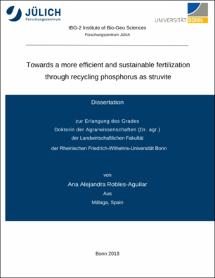Towards a more efficient and sustainable fertilization through recycling phosphorus as struvite

Towards a more efficient and sustainable fertilization through recycling phosphorus as struvite

| dc.contributor.advisor | Rascher, Uwe | |
| dc.contributor.author | Robles-Aguilar, Ana Alejandra | |
| dc.date.accessioned | 2020-04-24T15:26:57Z | |
| dc.date.available | 2020-04-24T15:26:57Z | |
| dc.date.issued | 08.11.2018 | |
| dc.identifier.uri | https://hdl.handle.net/20.500.11811/7373 | |
| dc.description.abstract | Food and water security are dependent on the sustainable use of phosphorus (P). However, there is no single solution for achieving a phosphorus-secure future. P recovered and recycled from current waste streams (like manure) is an important approach to developing environmentally sustainable and biologically efficient fertilizers. In this framework, a promising example of a P recovery product from waste streams is struvite (MgNH4PO4 6H2O), a crystal precipitated after the anaerobic digestion of different biological waste streams. Struvite has reported positive results regarding yields and P uptake for different crop species; however, there are still some limitations. P availability from struvite is highly influenced by the soil pH, which can be further modified by nutrients added to the soil or by plant and microbial activy in the rhizosphere. The main challenges are i) to understand the essential aspects that have a major effect on struvite availability, and ii) to focus on those traits that will increase struvite availability and therefore improve fertilizer use efficiency. With this apporoach, struvite value will increase, making it more competitive against mineral fertilizers. To understand which aspects modify struvite availability, the response of different plant species with contrasting strategies to mobilize nutrients (i.e. maize, lupine, and tomato) to various P applications was analyzed at different time points and plant growth stages. Likewise, the effect of soil pH, and method and duration of application were studied. Plant species have different morphological and physiological adaptations to increase the efficiency of P acquisition. Under this premise, a particular focus was put on root traits that would have an effect on phosphorus bioavailability and spatial availability. It was concluded that struvite has the same P fertilizer efficiency as mineral sources regarding biomass production, P uptake efficiency, and allometric studies of root–shoot relations. Moreover, it was validated that the following traits contributed to increase struvite use efficiency: i) the results from the automatic shoot phenotyping analyses support the idea of struvite being a slow-release; compared to triple-superphosphate (TSP), struvite-fertilized plants had lower initial leaf area, but later higher biomass ii) plant responses were conditoned by the nutrients applied with the struvite. It was confirmed that nitrate increased root biomass due to a higher number of primary roots, while ammonium increased the phosphorus uptake efficiency from struvite due to rhizosphere acidification iii) it was observed that lupine plants acidified the soil due to a high release of carboxylates by the roots. In contrast to the readily available P source K2PO4, the carobxylate exudation increased when struvite was applied, mobilizing the struvite-P at neutral conditions; iv) the microbial community analyzed did not shift between fertilizers used, as much as between plant species. Throughout this thesis, the use of invasive and non-invasive techniques, revealed different plant responses at various growth stages above and below ground, depending on the P fertilizer applied. It was shown that struvite solubility will not only depend on the soil pH but also will be modulated by the plant species and the way in which it is applied (e.g combined with other nutrients). In addition to yield analyses, studies of root morphological and physiological adaptations to P application provided a more detailed report of traits that would increase struvite use efficiency. It was shown that struvite, with a slower release, has the potential to be a more efficient method of fertilizing plants than the application of conventional, highly soluble P fertilizers. Likewise, the use of plants that can actively acidify the soil, combined with the application of the struvite with ammonium-N, will increase the P use efficiency. For future applications, those traits can be used to select candidate plants that will increase the use effiiciency of struvite, underlying mechanisms that will also ensure high yields. Those studies have the potential to be applied for other recovered products, increasing the efficiency and promoting the recycling of nutrients. | en |
| dc.language.iso | eng | |
| dc.rights | In Copyright | |
| dc.rights.uri | http://rightsstatements.org/vocab/InC/1.0/ | |
| dc.subject.ddc | 630 Landwirtschaft, Veterinärmedizin | |
| dc.title | Towards a more efficient and sustainable fertilization through recycling phosphorus as struvite | |
| dc.type | Dissertation oder Habilitation | |
| dc.publisher.name | Universitäts- und Landesbibliothek Bonn | |
| dc.publisher.location | Bonn | |
| dc.rights.accessRights | openAccess | |
| dc.identifier.urn | https://nbn-resolving.org/urn:nbn:de:hbz:5n-52484 | |
| ulbbn.pubtype | Erstveröffentlichung | |
| ulbbnediss.affiliation.name | Rheinische Friedrich-Wilhelms-Universität Bonn | |
| ulbbnediss.affiliation.location | Bonn | |
| ulbbnediss.thesis.level | Dissertation | |
| ulbbnediss.dissID | 5248 | |
| ulbbnediss.date.accepted | 07.05.2018 | |
| ulbbnediss.institute | Landwirtschaftliche Fakultät : Institut für Nutzpflanzenwissenschaften und Ressourcenschutz (INRES) | |
| ulbbnediss.fakultaet | Landwirtschaftliche Fakultät | |
| dc.contributor.coReferee | Eichert, Thomas |
Dateien zu dieser Ressource
Das Dokument erscheint in:
-
E-Dissertationen (1117)




